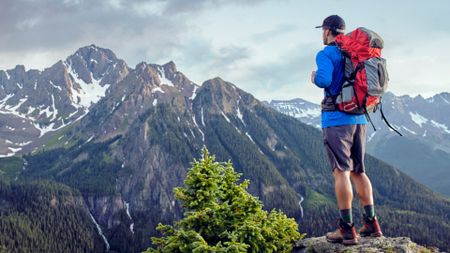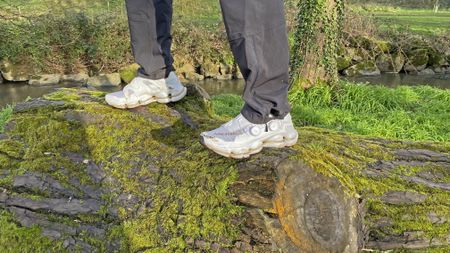

If you're heading off on a walking trip, getting your hiking packing list right is vital. But what exactly should you wear on a hike? And what should be in your bag for the next day's excursion? I spoke to Marie Chenge, a DofE Supervisor and Trainee Mountain Leader, to share what she wears and packs on her adventures in the mountains.
Marie has ventured on many a mountainous hiking excursion – recently as part of a team embarking on a 2-day Jack Wolfskin 'Wolftrail' trek above the snowline in the Austrian Alps – so she has plenty of experience packing for these kinds of trips.
While she rightly points out that the duration of the trip, terrain, weather, temperature and climate will all make a difference to what you need in your bag, what follows is still an excellent starting point for putting together your own trusty hiking packing list.
What to wear on a hike
"In general, I will typically hike in a short-sleeved/long-sleeved base layer and have with me another layer such as a fleece or softshell jacket, and then a windproof / waterproof jacket and waterproof trousers. I also typically have a synthetic down jacket, hat, gloves and buff with me," says Marie. "Then depending on the hike, the rest of my clothes will go into a bigger rucksack and I will usually have several base layers, mid-layers, bottoms and socks to rotate across the days!"
Like most outdoorsy people, Marie's hiking packing list combines many layers of clothing – she says that multiple thinner layers work better than one thick layer, or you can easily remove or add a layer as required ("You will get warm going uphill, but will need to put on extra layers when it’s windy or you stop for breaks for example.")
Now let's dig into Marie's hiking packing list, with more tips for each item.
1. Good hiking boots
If you're weighing up what to spend a bit more on, Marie says you should prioritise your footwear. "Ill-fitting boots and shoes will make or break your trek/experience," she emphasises. She suggests heading into a reputable outdoors shop so you can get advice from staff based specifically on the kinds of hikes you want to be doing.
Sign up to the T3 newsletter for smarter living straight to your inbox
Get all the latest news, reviews, deals and buying guides on gorgeous tech, home and active products from the T3 experts
Don't forget to test your shoes out on an incline – many shops will have a ramp you can use for this purpose. "You should be getting a pair of boots/shoes that have some toe room so that your toes don’t bash the end on a downhill and get black toenails," she explains. "Usually you may go up 0.5 to 1 size up to allow for this depending on the make."
If you can't get into a shop, we have guides to the best hiking boots for women and the best hiking boots for men, which have plenty of tried-and-tested options in them. And of course, make sure you pack a pair of quality hiking socks, too.
2. A waterproof and windproof shell jacket
You can never rely on the weather behaving well for you, so packing a jacket to keep out rain and provide a buffer against the wind is essential. You want something that's not only weatherproof, but also nice and breathable, so you can hike comfortably in it. Look for Gore-Tex or an own-brand equivalent such as Jack Wolfskin’s Texapore Ecosphere, and make sure you pick a jacket with a hood, too! Marie suggests the Jack Wolfskin Tasman Peak Jacket, and you'll find some more recommendations in our best waterproof jacket guide.

Marie Cheng on the Wolftrail hike
3. Synthetic down or fleece jackets
Your waterproof shell will keep you dry but not warm, so layer it over a jacket that's designed to provide some heat. If you're going for a down-style jacket, Marie suggests synthetic stuffing, because real down does not like getting wet, and you don't want to ruin it if you do get caught in an unexpected shower. Or if you fancy a fleece, our best fleece jackets guide has advice and recommendations.
4. Base layers
These sit next to your skin, and form the foundation of your layering system. "There are a lot of more basic options out there," advises Marie. "Just make sure they aren’t cotton and wick away your sweat. The idea being that you want the moisture to escape so that you are dry, if for example you sweat going up a hill, then cool down when you reach the top."
You can pick long or short-sleeved, depending on your preference and the weather. Our best base layers guide includes plenty of options, or if you're heading somewhere cold, our best ski base layers are designed to offer more warmth.
5. Beanies, gloves and a buff
Self-explanatory, but these will help lock in heat in chilly conditions without adding too much weight to your bag. Don't underestimate the warming powers of a buff around your neck to stop the drafts escaping down your top! If you're on a budget, you might not need the most technical options here. "There are a lot of more cost effective options for these out there that do the job," says Marie.
6. Well-fitting backpack
Your backpack choice is another thing that can make or break a trip, says Marie. And here, fit is key, so it's worth checking this before you make a purchase. "The load of the backpack should never be on your back and should be on your hips, so ask someone in the shop to help make sure that the backpack straps are done correctly," says Marie. "Usually I start with everything loose and then tighten the straps accordingly so the pack is sitting right. Also, get a backpack with a waist and chest strap."
We have a separate guide walking you through how to fit a hiking backpack, so consult that to make sure you're set up correctly, and for some recommendations on what to buy, head to our best hiking backpack guide.
7. Spare clothing
"Depending on the terrain and nature of the hike, I was always advised to pack enough in your bag to make sure that if for any reason you or someone else got into trouble, there is enough in there to keep you warm till help arrives!" says Marie.
8. Dry bags
Marie's hot packing hack is to use dry bags to organise and store your clothing in your backpack. "Not only will they keep your kit dry, but they… also compress to make everything smaller." For longer excursions, you could follow Marie's lead and use separate bags for different categories of clothing – a dry bag just for socks and underwear, one gloves and beanies, one for base layers, for example.
9. ... and some extra bits you probably forgot
That's about it for clothing, but there are some extras you might forget that Marie would like to draw your attention to.
"Other things I usually take with me especially on multi-day treks is a power bank, to make sure your phone / navigation / GPS equipment is fully charged," says Marie. "Also I also carry emergency toilet roll, always! A good space saving tip is take out the toilet roll inner out and squash the toilet roll down and put it in a waterproof bag."
Ruth is a lifestyle journalist specialising in sleep and wellbeing. She has tested more mattresses than her small flat can handle and will talk at length about them to anyone who shows even a passing interest, and has had to implement a one-in-one-out pillow policy for fear of getting smothered in the night. As well as following all the industry trends and advancements in the mattress and bedding world, she regularly speaks to certified experts to delve into the science behind a great night's sleep, and offer you advice to help you get there. She's currently Sleep Editor on Tom's Guide and TechRadar, and prior to that ran the Outdoors and Wellness channels on T3 (now covered by Matt Kollat and Beth Girdler-Maslen respectively).
-
 LG's 2025 TVs dump DTS for Dolby – is Eclipsa incoming?
LG's 2025 TVs dump DTS for Dolby – is Eclipsa incoming?LG has once again dropped DTS audio support from its TVs – but a new format may be ready to take its place
By Carrie Marshall Published
-
 I saw Samsung’s new Bespoke AI appliances, and I’m most excited about its washing machines
I saw Samsung’s new Bespoke AI appliances, and I’m most excited about its washing machinesSamsung announces new AI laundry line-up
By Bethan Girdler-Maslen Published
-
 YETI has discounted a ton of its best-selling coolers and tumblers in Amazon’s Big Spring Sale
YETI has discounted a ton of its best-selling coolers and tumblers in Amazon’s Big Spring SaleJust in time for the warmer months
By Bryony Firth-Bernard Published
-
 GoPro's latest flagship action cam just got a major price cut in Amazon's spring sale deal
GoPro's latest flagship action cam just got a major price cut in Amazon's spring sale dealYou can pick up the Hero 13 Black with almost 20% off
By Lee Bell Published
-
 No stupid questions: how often should I clean my hiking boots?
No stupid questions: how often should I clean my hiking boots?Want to extend the life of your hiking boots? This is how often you should be cleaning them
By Bryony Firth-Bernard Published
-
 When is the best time of year to go on a hike?
When is the best time of year to go on a hike?Not sure when’s best to hit the trails? This is what an outdoor expert recommends
By Bryony Firth-Bernard Published
-
 How to pack your rucksack for a hiking or camping trip
How to pack your rucksack for a hiking or camping tripPack properly, save space and get easier access to the items you need the most
By Bryony Firth-Bernard Published
-
 I tested these high-tech Merrell hikers and was taken aback by their biggest strength
I tested these high-tech Merrell hikers and was taken aback by their biggest strengthThe SpeedArc Surge Boa combines speed, comfort, and adjustability but has some issues with figuring out its target audience
By Pat Kinsella Published
-
 How to clean your hiking backpack for your next outdoor adventure
How to clean your hiking backpack for your next outdoor adventureIt's time to give your backpack some well-deserved TLC
By Bryony Firth-Bernard Published
-
 3 essential strength exercises every hiker should be doing, according to an outdoor expert
3 essential strength exercises every hiker should be doing, according to an outdoor expertBoost your performance on the trails and reduce the likelihood of injuries
By Bryony Firth-Bernard Published
